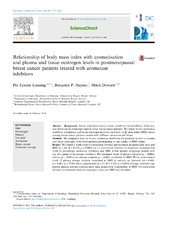| dc.contributor.author | Lønning, Per Eystein | en_US |
| dc.contributor.author | Haynes, Benjamin P. | en_US |
| dc.contributor.author | Dowsett, Mitch | en_US |
| dc.date.accessioned | 2014-12-05T08:23:04Z | en_US |
| dc.date.accessioned | 2014-12-05T11:00:46Z | en_US |
| dc.date.accessioned | 2014-12-10T08:31:53Z | |
| dc.date.available | 2014-12-10T08:31:53Z | |
| dc.date.issued | 2014-02-04 | eng |
| dc.identifier.issn | 0959-8049 | |
| dc.identifier.uri | https://hdl.handle.net/1956/8870 | |
| dc.description.abstract | Background: Recent data have raised concern about the clinical efficacy of aromatase inhibitors in overweight and/or obese breast cancer patients. We report in vivo aromatase inhibition and plasma and tissue oestrogen levels in relation to body mass index (BMI) status among breast cancer patients treated with different aromatase inhibitors. Methods: We compared data on in vivo aromatase inhibition (64 patients) as well as plasma and tissue oestrogen levels from patients participating in our studies to BMI values. Results: We found a weak positive correlation between pretreatment aromatisation level and BMI (n = 64; R = 0.236; p = 0.060) but no correlation between on-treatment aromatisation levels or percentage aromatase inhibition and BMI within patient subgroups treated with any of a panel of aromatase inhibitors. Pre-treatment levels of plasma estradiol (p < 0.001), estrone (p = 0.001) and estrone sulphate (p = 0.002) correlated to BMI. While on-treatment levels of plasma estrane sulphate correlated to BMI in patients on letrozole (R = 0.601; p = 0.001; n = 25 for all) or anastrozole (n = 12; R = 0.611; p = 0.035) therapy, letrozole suppressed plasma estrone sulphate more than anastrozole independent of BMI. No correlation between on-treatment tumour oestrogen levels and BMI was recorded. Conclusions: Our unique data do not support a lack of effective aromatase inhibition in overweight patients or therefore a need for alternative therapy. The higher levels of estrogens in overweight postmenopausal breast cancer patients before and during aromatase inhibition may be due to effects of BMI on oestrogen metabolism rather than aromatisation. | en_US |
| dc.language.iso | eng | eng |
| dc.publisher | Elsevier | eng |
| dc.rights | Attribution-NonCommercial-NoDerivs CC BY-NC-ND | eng |
| dc.rights.uri | http://creativecommons.org/licenses/by-nc-nd/3.0/ | eng |
| dc.subject | BMI | eng |
| dc.subject | Overweight | eng |
| dc.subject | Obesity | eng |
| dc.subject | Estradiol | eng |
| dc.subject | Aromatase | eng |
| dc.subject | Breast cancer | eng |
| dc.subject | Endocrine therapy | eng |
| dc.title | Relationship of body mass index with aromatisation and plasma and tissue oestrogen levels in postmenopausal breast cancer patients treated with aromatase inhibitors | en_US |
| dc.type | Peer reviewed | |
| dc.type | Journal article | |
| dc.date.updated | 2014-12-05T08:23:04Z | en_US |
| dc.description.version | publishedVersion | en_US |
| dc.rights.holder | Copyright 2014 The Authors | |
| dc.identifier.doi | https://doi.org/10.1016/j.ejca.2014.01.007 | |
| dc.identifier.cristin | 1158821 | |
| dc.source.journal | European Journal of Cancer | |
| dc.source.40 | 50 | |
| dc.source.14 | 6 | |
| dc.source.pagenumber | 1055-1064 | |
| dc.subject.nsi | VDP::Medical sciences: 700::Clinical medical sciences: 750::Oncology: 762 | eng |
| dc.subject.nsi | VDP::Medisinske fag: 700::Klinisk medisinske fag: 750::Onkologi: 762 | nob |

